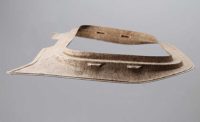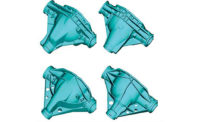Lightweighting has been a hot topic in the auto industry for many years. However, most efforts have focused on body, chassis and interior applications. Automotive engineers are now turning their attention to power train components.
“We’re seeing more of this and it’s taking a holistic approach—mass drives mass,” says Bob Dolan, business unit director of power train design and integration at IAV Automotive Engineering Inc. “If you can make the engine or the transmission lighter, then the structures supporting them can be lighter, and we’ve seen this snowball effect taking place across the vehicle.
“There has certainly been a lot done with plastic and aluminum body panels,” adds Dolan. “But, there isn’t an engine program we’re involved with where mass isn’t religiously tracked for each component, subassemblies and the engine as a whole.
“We expect to see more material substitutions, such as aluminum for iron, and more magnesium and titanium being used,” Dolan points out. “Likewise, we continue to see more composites, plastics and alternative materials on the engine peripheral, as well.”
In addition to using alternative materials, weight reduction can be accomplished by using higher strength materials. More strength means less material is needed to achieve the same performance characteristics. And, less material means less mass.
Early efforts to cut power train weight focused on substituting aluminum for iron in applications such as manifolds and cylinder heads. However, it’s easier to reduce the weight of some components than others.
“The big gains are made with the stationary structures through material substitutions, simply because that’s where there’s the largest volume of materials,” says Dolan. “With the mechanisms inside the engine, which are either rotating or reciprocating, the loads are typically higher, so you have a harder time realizing mass reduction.”
It’s more challenging to reduce the weight of internal structures, like valve trains, because these systems are already optimized for mass.
“To take more mass out of them requires very careful and deliberate design, in addition to a deep understanding of all the boundary conditions,” Dolan warns. “The piston is probably the toughest, because it has to be strong enough to support combustion loads and it’s the primary piece that drives mass. These pieces you need to counterbalance the most.
“To have a good engine balance, you have to have counterweighting,” adds Dolan. “So, if you can reduce the mass of the piston, you can reduce the mass of the counterweight and, therefore, start bringing the whole engine back down.”
Engineers in Germany recently built a cylinder casing out of fiber-reinforced composites. “It weighs around 20 percent less than the equivalent aluminum component and costs the same,” claims Lars-Fredrik Berg, manager of lightweight power train design research at the Fraunhofer project group for new drive systems.
“It seems an obvious solution, but getting there involved numerous technical challenges,” explains Berg. “The materials used have to be able to withstand extreme temperatures, high pressure and vibrations without suffering damage.”
Not all power train components are good candidates for using composite materials. “Some components lend themselves to that,” says Dolan. “[They’re] typically on the engine peripheral, like large covers and front-end housings.”
“With some of the internal components, we don’t see immediate paybacks for something as exotic as carbon fiber,” adds Dolan. “However, we will continue to see more composites used in manifolds and cam covers.
As power trains become lighter, engineers may need to adopt new or evolved assembly processes. “As you optimize a component for its function in the engine, you have to look at all of the features that are in each component to support manufacturing and assembly,” Dolan points out.
“Those need to be optimized as well,” says Dolan. “There are a lot of features and considerations in the engine that are not related to the function of the engine, but rather to its manufacture and assembly. These need to be scaled down, slimmed down or combined with other features that are already present in the engine in order to realize certain mass reductions.”



